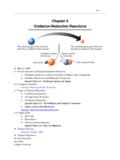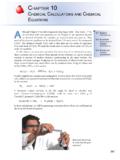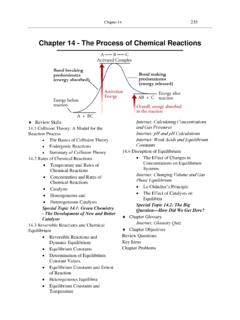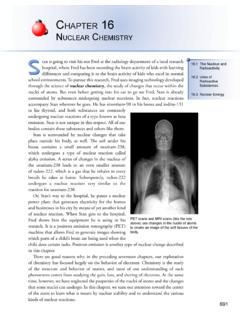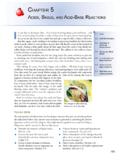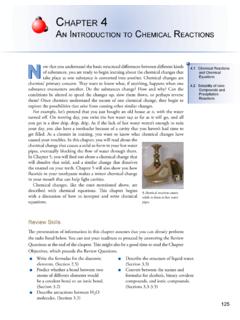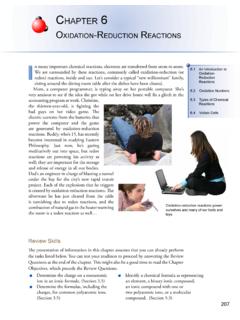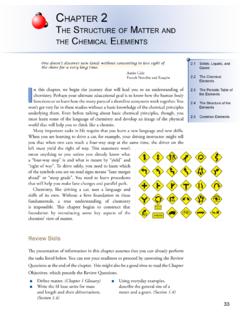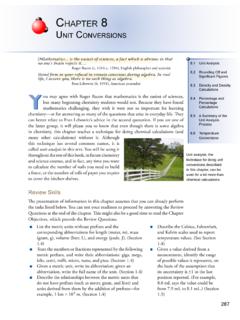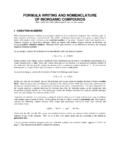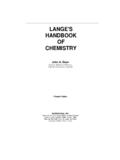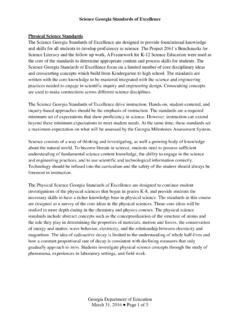Transcription of Chapter 9 ChemiCal C and C Formulas - Mark Bishop
1 Chapter 9 ChemiCal CalCulations and ChemiCal Formulas329n order to explore and make use of the seemingly limitless changes that matter can undergo, chemists and chemistry students often need to answer questions that begin with, How The research chemist who is developing a new cancer drug wants to know, How much radioactive boron 10 do I need to make 5 g of the drug? At a ChemiCal plant where the fat substitute Olestra is manufactured from white sugar and vegetable oil, a business manager asks a chemist, How much sucrose and cottonseed oil should I order if we need to produce 500 Mg of Olestra per day? In an experiment for a chemistry course you are taking, you might be asked, How much magnesium oxide can be formed from the reaction of your measured mass of magnesium with the oxygen in the air?
2 This Chapter and the chapters that follow provide you with the tools necessary to answer these questions and many others like A Typical Relating Moles to Number of Molar Mass and ChemiCal Relationships Between Masses of Elements and Determination of Empirical and Molecular Formulas Write or recognize the definition of isotope. (Section ) Describe the general structure of molecular and ionic compounds. (Sections and ) Convert between the names of compounds and their ChemiCal Formulas . (Section ) Report the answers to calculations to the correct number of significant figures. (Section ) Use percentages as conversion factors. (Section ) Make unit conversions. (Section )All of these people ask questions that begin, How Review SkillsThe presentation of information in this Chapter assumes that you can already perform the tasks listed below.
3 You can test your readiness to proceed by answering the Review Questions at the end of the Chapter . This might also be a good time to read the Chapter Objectives, which precede the Review Questions. A Typical Problem1 To avoid potential confusion, the states (s), (l), (g), and (aq) are not mentioned in equations describing industrial reactions in Chapters 9 and 10. Many industrial reactions are run at temperatures and pressures under which the states of substances differ from what would be expected at room temperatures and pressures. For example, the Ca3(PO4)2 in the first equation on this page is a solid under normal conditions but a liquid at 2000 C; SiO2 is also solid under normal conditions but a glass (or semisolid) at 2000 you are a chemist at a company that makes phosphoric acid, H3PO4, for use in the production of fertilizers, detergents, and pharmaceuticals.
4 The goal for your department is to produce H3PO4 (and water) in the last stage of a three step process known as the furnace method. (We will be using the furnace method as a source of practical examples throughout this Chapter and in Chapter 10.) The first step in the furnace method is the extraction of phosphorus from phosphate rock by heating the rock with sand and coke to 2000 C. The phosphate rock contains calcium phosphate, Ca3(PO4)2; the sand contains silicon dioxide, SiO2; and coke is a carbon rich substance that can be produced by heating coal to a high temperature. At 2000 C, these three substances react as follows:12Ca3(PO4)2 + 6 SiO2 + 10C 4P + 10CO + 6 CaSiO3In the second step, the step on which we will focus in this Chapter , the phosphorus, P, is reacted with oxygen in air to form tetraphosphorus decoxide, P4O10: 4P(s) + 5O2(g) P4O10(s)The third and final step is the reaction of P4O10 with water to form phosphoric acid: P4O10(s) + 6H2O(l) 4H3PO4(aq)Your colleagues who are responsible for the first step, the production of pure phosphorus, estimate that they can supply you with 104 kg of phosphorus per day.
5 The production manager asks you to figure out the maximum mass of P4O10 that can be made from this amount of phosphorus. The tools described in this Chapter , in combination with the unit analysis method, enable you to satisfy this s begin by thinking about how unit analysis might be used to solve your problem. Your production manager is asking you to convert from amount of phosphorus, P, to amount of tetraphosphorus decoxide, P4O10. To do this, you need a conversion factor relating amount of P to amount of P4O10. The ChemiCal formula , P4O10, provides such a conversion factor. It shows that there are four atoms of phosphorus for each molecule of atoms P1 moleculeor4 atoms P1 molecule330 Chapter 9 ChemiCal Calculations and ChemiCal Relating Mass to Number of Particles 331 But how many atoms of phosphorus are in our 104 kg P?
6 Until we know that, how can we tell how much P4O10 we ll be able to produce? Unfortunately, atoms and molecules are so small and numerous that they cannot be counted directly. We need a conversion factor that converts back and forth between any mass of the element and the number of atoms contained in that mass. If we can determine the number of phosphorus atoms in 104 kg P, we can use the second conversion factor at the bottom of the last page to determine the number of molecules of P4O10. But your production manager doesn t want to know the number of P4O10 molecules that you can make. She wants to know the mass of P4O10 that can be made. That means we also need a conversion factor that converts back and forth between any mass of the compound and the number of molecules contained in that mass.
7 The main goal of the first half of this Chapter is to develop conversion factors that convert between mass and number of particles. Relating Mass to Number of ParticlesBefore we develop conversion factors to convert back and forth between any mass of an element and the number of atoms contained in that mass, let s consider a similar task that may be easier to visualize. We will calculate the number of carpenter s nails in a hardware store bin. Imagine that you have decided to make a little money for schoolbooks by taking a temporary job doing inventory at the local hardware store. Your first task is to determine how many nails are in a bin filled with nails. There are a lot of nails in the bin, and you do not want to take the time to count them one by one. It would be a lot easier to weigh the nails and calculate the number of nails from the mass.
8 To do this you need a conversion factor that allows you to convert from the mass of the nails in the bin to the number of nails in the bin. Let s assume that you individually weigh 100 of the nails from the bin and find that 82 of them have a mass of g each, 14 of them have a mass of g each, and the last four have a mass of g each. From this information, you can calculate the average mass of the nails in this sample, taking into consideration that 82% of the nails have a mass of g, 14% have a mass of g, and 4% have a mass of g. Such an average is known as a weighted average. You can calculate the weighted average of the nails masses by multiplying the decimal fraction of each subgroup of nails times the mass of one of its members and adding the results of these multiplications. ( g) + ( g) + ( g) = gAn industrial chemist must be able to calculate the amounts of reactants necessary to run an efficient reaction and predict the amount of product that will the weighted average mass of the nails in this sample is g.
9 It is possible that none of the nails in our bin has this mass, but this is a good description of what we can expect the average mass of each nail in a large number of nails to be. It can be used as a conversion factor to convert between mass of nails and number of nails. g nails1 nailWe can measure the total mass of the nails in the bin and then use the conversion factor above to determine their number. For example, if the nails in the bin are found to weigh 218 pounds, the number of nails in the bin is: ? nails = 218 lb g1 lb1 g nails= 104 nailsThere is some uncertainty in this result due to our reliance on measuring rather than counting, but this procedure is a lot faster than the alternative of counting over 26,000 nails. The key point to remember is that this procedure allows us to determine the number of objects in a sample of a large number of those objects without actually counting them.
10 Our procedure allows us to count by weighing. It is often convenient to describe numbers of objects in terms of a collective unit such as a dozen (12) or a gross (144). The number 104 is large and inconvenient to use. We might therefore prefer to describe the number of nails in another way. For example, we could describe them in terms of dozens of nails, but 218 pounds of our nails is 103 dozen nails, which is still an awkward number. We could use gross instead of dozen. A gross of objects is 144 objects. The following calculation shows how to create a conversion factor that converts between mass of nails and gross of nails: ? g nails1 gross g nails1 nail144 nails1 gross nails544 g nails1 gross nails==We can use this conversion factor to determine the number of gross of nails in 218 pounds of nails.
